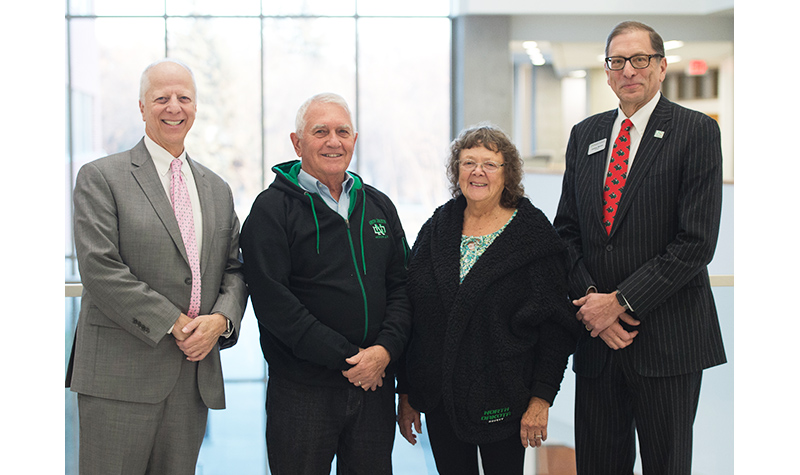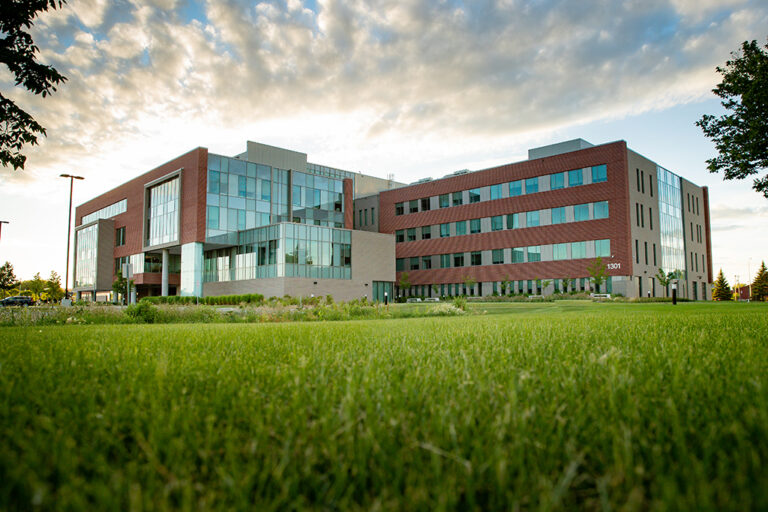From the Dean
 This past Tuesday, Susan and I attended a very special event on the Northeast (Grand Forks) campus. Along with dozens of others from the SMHS, UND, and Grand Forks community, we attended the opening exhibition of the UND School of Medicine & Health Sciences Art Gallery located on the second floor of the new building. The exhibition, consisting of 13 works selected from the incredible UND art collection (over 30,000 pieces!), will stay at the School through April 17, 2020, when we will welcome a new exhibition after it premieres at the Empire Arts Center in downtown Grand Forks. The theme of the current exhibit is “School of Paris: Selected Works on Paper, Published in Paris circa 1934-39.” The works are by such noted early 20th century artists as Kandinsky, Miró, Matisse, Chagall, and Ernst. The UND SMHS Art Gallery has become a reality thanks to the outstanding efforts of Sarah Heitkamp, manager and curator for UND Art Collections and instructor in the Department of Art & Design, and her colleagues, along with the support of Thomas DiLorenzo, vice president for Academic Affairs and Provost. We were also pleased to announce the financial support of Pete and Eunice Kuhn, who established the UND Art Collections Endowment for Preservation and Education to support art projects across campus.
This past Tuesday, Susan and I attended a very special event on the Northeast (Grand Forks) campus. Along with dozens of others from the SMHS, UND, and Grand Forks community, we attended the opening exhibition of the UND School of Medicine & Health Sciences Art Gallery located on the second floor of the new building. The exhibition, consisting of 13 works selected from the incredible UND art collection (over 30,000 pieces!), will stay at the School through April 17, 2020, when we will welcome a new exhibition after it premieres at the Empire Arts Center in downtown Grand Forks. The theme of the current exhibit is “School of Paris: Selected Works on Paper, Published in Paris circa 1934-39.” The works are by such noted early 20th century artists as Kandinsky, Miró, Matisse, Chagall, and Ernst. The UND SMHS Art Gallery has become a reality thanks to the outstanding efforts of Sarah Heitkamp, manager and curator for UND Art Collections and instructor in the Department of Art & Design, and her colleagues, along with the support of Thomas DiLorenzo, vice president for Academic Affairs and Provost. We were also pleased to announce the financial support of Pete and Eunice Kuhn, who established the UND Art Collections Endowment for Preservation and Education to support art projects across campus.
Thanks to these individuals, the School will now feature two new temporary exhibitions per year that will complement the more than 100 pieces on permanent display throughout the four floors of the new building. By the way, we are putting the finishing touches on a “guided self-tour” brochure that will be available soon that catalogues all of the pieces of art in the building. I’ll let you know when it is ready.
Why am I so pleased with the artwork in the building? Well, in addition to making the building even more beautiful and pleasing to the eye, the works, embedded as they are in a building dedicated to the study of health and treatment of disease, emphasize the critical juncture between art and science. Art reflects a very personal reaction to the world; it is all about emotion and reaction to the environment. For example, the sense of foreboding in these pre-World War II works in the School of Paris exhibition is palpable. The art reminds us and our students that we are not simply studying the disease process; rather, we are trying to help people who happen to have a disease. This is implicit in the pedagogical model we have used with our medical students for over 20 years, which is called patient-centered learning or PCL. In PCL, the focus of study is the patient, and small groups of students work to ask questions about the disease process involved in a particular human being. By shifting the focus from the disease process to the patient, we try to emphasize the humanistic aspects of health care. At the case wrap-up that concludes each week of study for first- and second-year medical students, we typically make the patient under study for the prior week available for discussion with the students. It usually is a highly instructive event, as the students get to hear firsthand what dealing with a given disease was/is like for the affected patient and family.
I encourage you to stop by the event space on the second floor of the building to view the pieces in the UND SMHS Art Gallery. And be sure to plan to see the future exhibitions that will grace the Gallery in the coming months and years.
Finally, many of us are off to attend the annual meeting of the Association of American Medical Colleges (AAMC). The AAMC meeting is well-attended by representatives from virtually all of the 154 medical schools in the U.S. and the 17 in Canada. We meet with colleagues and attend meetings that explore best practices and innovations in the education of medical and health sciences students. After we return from the meeting, all the attendees get together to debrief and discuss the most important things we heard at the meeting. I’ll provide a summary of that debrief to you in the coming weeks.
Joshua Wynne, MD, MBA, MPH
Interim President and Vice President for Health Affairs, UND
Dean, UND School of Medicine & Health Sciences



